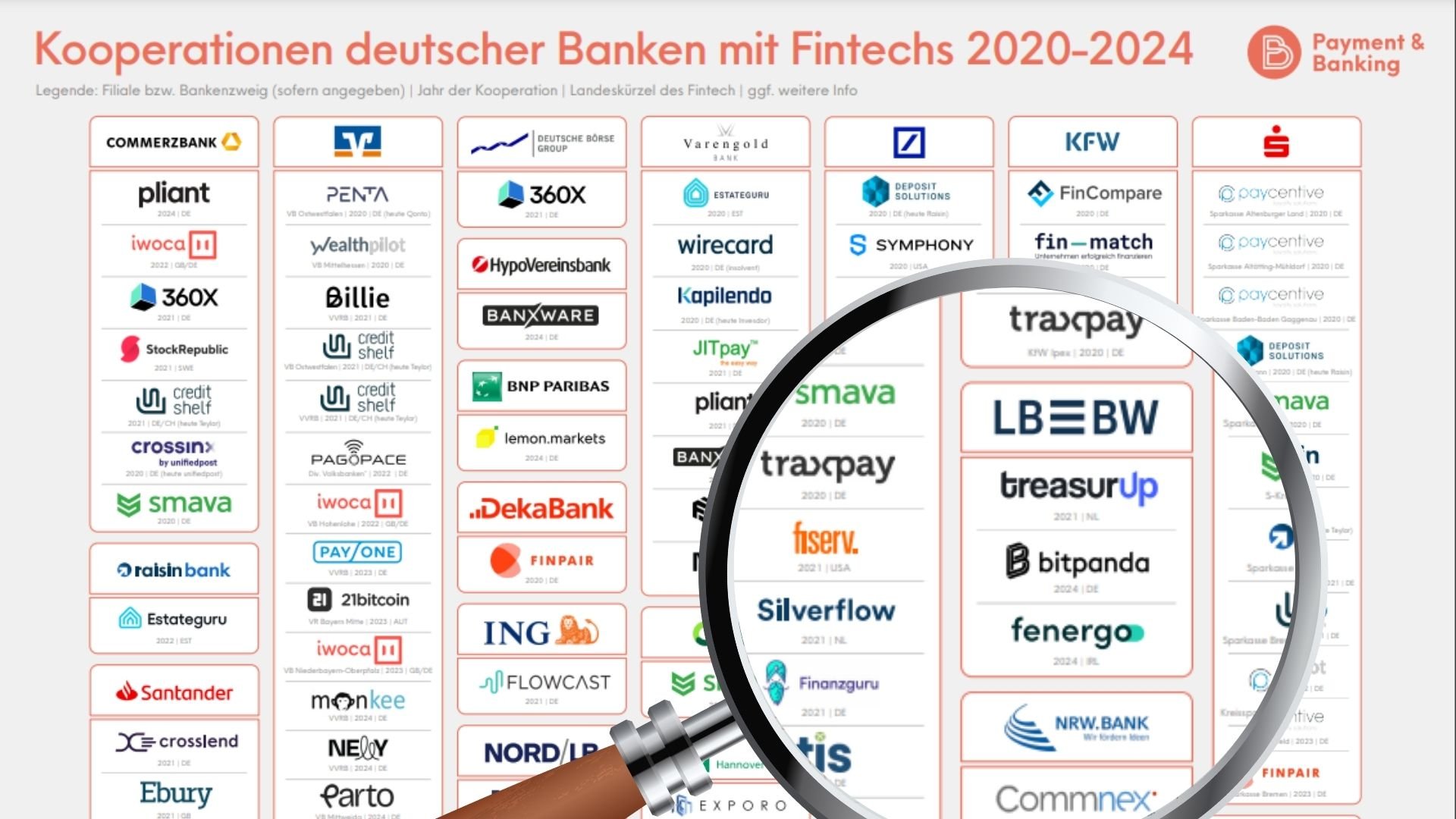Der Hype um Embedded Finance ist ungebrochen: Laut einer aktuellen Studie der Private-Equity-Gesellschaft Lightyear Capital wird der Wert der Embedded Finance-Branche bis 2030 bei 7,2 Billionen US-Dollar liegen. Das entspricht dem doppelten Gesamtwert der weltweit 30 größten Banken. Besonders großes Potenzial werden integrierte Zahlungsdienstleistungen im E-Commerce und der Gesundheitsbranche haben, die über die Hälfte des Marktes ausmachen werden.
Aufgrund des großen Potenzials hat nun ein Wettlauf um entsprechende Marktanteile begonnen: So kommt es jetzt darauf an, schnell genug zu sein und sich an das veränderte Umfeld anzupassen. Unternehmen, die sich nicht rechtzeitig auf diese Neuerungen einstellen, drohen empfindliche Umsatzeinbußen und wertvolle Kunden zu verlieren.
Entwicklung und Potenzial der Branche
Der Bankensektor befindet sich in einem massiven Transformationsprozess. Im Zuge der Öffnung der Finanzindustrie durch Open Banking drängen immer mehr branchenfremde Unternehmen in den Markt und bieten ihren Kunden integrierte Finanzdienstleistungen in ihrem Portfolio an. Neben Krediten können diese Services auch klassische Banking-Dienste, Zahldienste und Versicherungen umfassen. In Deutschland gehören in diesem Bereich vor allem Nicht-Finanzunternehmen wie Lidl, MediaMarktSaturn, ADAC und Daimler Mobility zu den absoluten Vorreitern. Banken und andere Finanzinstitute haben sich lange Zeit sehr zurückhaltend verhalten, da sie Embedded Finance vor allem als Konkurrenz zu ihren Geschäftsmodellen betrachteten.
Doch seit einiger Zeit kommt Bewegung ins Spiel: Mittlerweile erkennen immer mehr Banken, dass sie aufgrund ihres tiefgreifenden Branchenwissens, ihrer Reichweite und Glaubwürdigkeit sowie ihren starken Bilanzen und dem direkten Zugang zu kostengünstigem Kapital die Möglichkeit haben, eine führende Rolle in der Kreation funktionierender Embedded Finance Modelle einzunehmen. Zudem sehen sie inzwischen deutlich die Vorteile, sich durch integrierte Zahlungsoptionen gegenüber ihren Wettbewerbern im hart umkämpften Finanzmarkt abzuheben und gleichzeitig neue Zielgruppen mit maßgeschneiderten und direkt integrierten Dienstleistungen zu erreichen.
Wie Finanzinstitute und Marken von Embedded Finance profitieren können
Die Vorteile für Embedded Finance liegen klar auf der Hand: Integrierte Finanzdienstleistungen können die Kundenloyalität steigern, die Anzahl der Kundenkontakte erhöhen und zusätzliche Einnahmequellen generieren. Gebrandete Kreditkarten dienen oftmals nicht nur als Zahlungsmittel, sondern auch zum Sammeln von Treue -oder Cashback-Punkten bei bestimmten Händlern. Unternehmen mit kundenzentrischen Geschäftsmodellen können die dadurch gewonnenen Kundendaten intelligent nutzen, um maßgeschneiderte Finanzprodukte in einer Qualität anzubieten, die von der eines persönlichen Finanzberaters nicht zu unterscheiden ist.
Finanzinstitute haben die Möglichkeit ihre integrierten Finanzdienstleistungen über Drittanbieter anzubieten: Anstatt darauf zu hoffen, dass Kunden auf direktem Wege auf ihre Dienstleistungen stoßen, werden diese über die Drittanbieter am Point-of-Sale angeboten. Auf diese Weise reagieren die Finanzinstitute auf ein verändertes Kundenverhalten: Laut einer Studie von PwC zum digitalen Bankgeschäft tendieren immer mehr Kunden dazu, ihre Zahlungsgeschäfte ausschließlich digital abzuwickeln.

Das wachsende Bewusstsein für das große Potenzial, welches ihnen Embedded Finance bietet, erkennen Marken zunehmend: Laut einer aktuellen Umfrage von OpenPayd gaben 92 % der Entscheider in Unternehmen an, in den nächsten fünf Jahren entsprechende Dienste einführen zu wollen. Nach den Haupttreibern für dieses Vorhaben gefragt, wählten die Entscheider vor allem Aspekte im Bereich der Kundeninteraktion aus. Eine große Mehrheit der Befragten sieht einen bedeutenden Vorteil von Embedded Finance Lösungen darin, das „Kundenerlebnis zu verbessern“ (85 %) und die „Zahl der Berührungspunkte mit der Marke zu erhöhen“ (84 %). Für 79% spielt auch die Möglichkeit, Mobile Wallets und Girokonto-Optionen zu bieten, eine große Rolle, dicht gefolgt von dem „Ausbau der Cross-Selling-Möglichkeiten“ (68 %). 46 % haben das Ziel, maßgeschneiderte Finanzdienste anzubieten. Als Hauptmotivation für diese Aktivitäten gaben die Entscheider die Erschließung neuer Einkommensquellen an.
Kund:innen sind bereit für Embedded Finance
Die Verbreitung von Digital Wallets und flexibler Finanzierung -und Kreditoptionen am Point-of-Sale werden dabei zunehmend vom Online-Handel und dem damit zusammenhängen digitalen Zahlungs-Boom erhöht. Laut einer gemeinsamen Studie von der Solarisbank und dem Handelsblatt Research Institute, würden 61 % der Deutschen Finanzdienstleistungen von Online-Shops beziehen. Zudem gaben mehr als ein Viertel der Deutschen (24 %) an, dass sie ein Girokonto bei Amazon eröffnen würden, gefolgt von Lidl und dm.
Was hält Unternehmen also noch davon ab, Embedded-Finance-Angebote in ihr Portfolio zu integrieren? Trotz des enormen Marktpotenzials und ihrer Bereitschaft am Marktwachstum teilhaben zu wollen, stoßen Marken aktuell noch auf große Hürden. Zu den größten Hindernissen zählen der hohe Zeit -und Kostenaufwand für die Markteinführung, mangelnde Erfahrung in der Software-Entwicklung und Zahlungsabwicklung sowie die zusätzlichen Ressourcen, die für die Entwicklung von Inhouse-Lösungen benötigt werden.

Um diese Probleme zu überwinden, kooperieren immer mehr Unternehmen mit bereits etablierten Dienstleistern von Embedded-Finance-Lösungen. Auf diese Weise können sie auf die bereits vorhandene Expertise zurückgreifen und Dienstleistungen schneller implementieren als im Alleingang.
Wie Embedded Finance bereits erfolgreich umgesetzt wurde: Am Beispiel der White-Label-Lösung von finleap connect
Als führender unabhängiger Open Banking-Anbieter in Europa, bietet finleap connect Embedded Finance-Lösungen in Kooperation mit der Solarisbank an und hat eine White-Label Lösung namens „Digital Bank“ entwickelt. Zwei Beispiel-Cases für eine erfolgreiche Umsetzung von Embedded Finance:
#1 Immobilienmarkt: Engel & Völkers Smart Money
Das Finanzinstitut Engel & Völkers Smart Money bietet eine ganzheitliche Vermögensplattform an, die Bankgeschäfte mit Immobilien verbindet. Engel & Völkers stellen Bankdienstleistungen hiermit insbesondere für Immobilieneigentümer und Investoren zur Verfügung. Zu diesem Zweck nutzt Engel & Völkers auf die von finleap connect entwickelte White-Label Lösung. Engel & Völkers Smart Money ist damit der erste Anbieter, der sich mit seinem Angebot speziell auf die Kundenbedürfnisse von Immobilienbesitzern und Investoren fokussiert hat. Engel & Völkers Smart Money bietet ein kostenloses Girokonto und eine Visa Debitkarte in Zusammenarbeit mit der Solarisbank an. Das Frontend, inklusive moderner Banking-Funktionen wie Multibanking und Apple Pay, wird von finleap connect zur Verfügung gestellt.
#2 Traditionelle Hausbank: Volksbank Bad Salzungen Schmalkalden eG
In diesem Fall kommt die White-Label-Lösung von finleap connect bei einem traditionellen Vertreter der Finanzbranche zum Einsatz: Bei der Volksbank Bad Salzungen Schmalkalden eG, die zu den Volksbanken Raiffeisenbanken gehört.
Die Volksbank Bad Salzungen Schmalkalden eG hat in Kooperation mit der Solarisbank und finleap connect die “VR Perfekt Fankarte” entwickelt. Das “Decoupled Debit”-Produkt wird von der Solarisbank in Form einer Fußball-Fankarte angeboten, mit dem Ziel die Bindung der Fans zum Verein auszubauen.
Embedded Finance muss zum Standard werden
Um sich für die Zukunft optimal aufzustellen, müssen Finanzinstitute und Marken gezielt Chancen für neues Wachstum abseits des Kerngeschäfts erarbeiten. Im Bereich Embedded Finance erfordert dies für Banken ein Umdenken sowie die Anpassung an neue technische Infrastrukturen. Die Vorteile sprechen jedoch für sich: Banken, die Embedded Services anbieten, erzielen höhere Umsätze. Embedded Finance ist eine einzigartige Gelegenheit für Finanzdienstleister und Nicht-Finanzdienstleister, auf allen Märkten Fuß zu fassen und neue Zielgruppen zu erreichen. Um an diesem Wachstumspotenzial teilzuhaben, bedarf es Plattformen und Systemen, die einfach einzurichten und zu bedienen sind.
Die Lösungen müssen sich nahtlos in die bestehenden Kunden-Ökosysteme einfügen. Um sich heutzutage einen Vorsprung zu verschaffen, brauchen Finanzinstitute und Nicht-Finanzunternehmen starke und etablierte Partner mit Banklösungen. Sie brauchen Partner mit einer nachgewiesenen Erfolgsbilanz und dem nötigen Fachwissen in den Bereichen Softwareentwicklung und Zahlungsverarbeitung. Schon mittelfristig wird kein Weg an Embedded Finance vorbeiführen.
Über die Autorin:
Katja Hunstock ist Expertin für Open Banking, Embedded Finance und Internationalisierungsstrategien für Finanzprodukte. Ihren Start bei finleap connect machte sie als eine der ersten Mitarbeitenden in der Niederlassung in Madrid. Seit August 2021 ist sie Chief Product Officer von finleap connect und verantwortet die Definition und Leitung der Produktstrategie und -vision sowie das Controlling des gesamten Produktportfolios des Unternehmens.

Jetzt Tickets für die Payment Exchange 2022 sichern
hier geht’s zum Ticket-ShoP!




